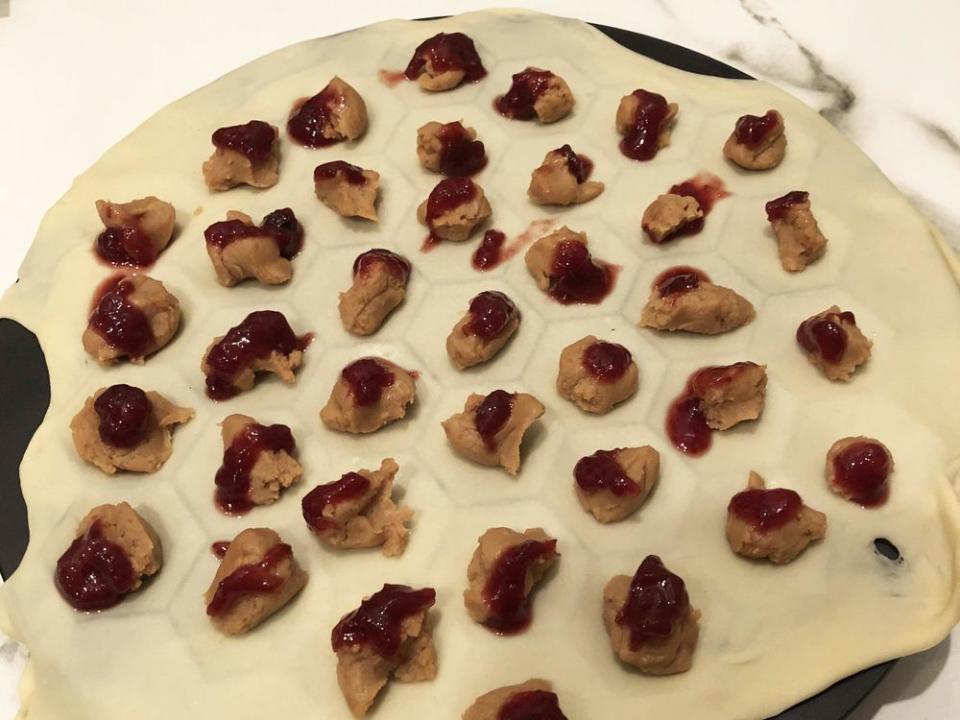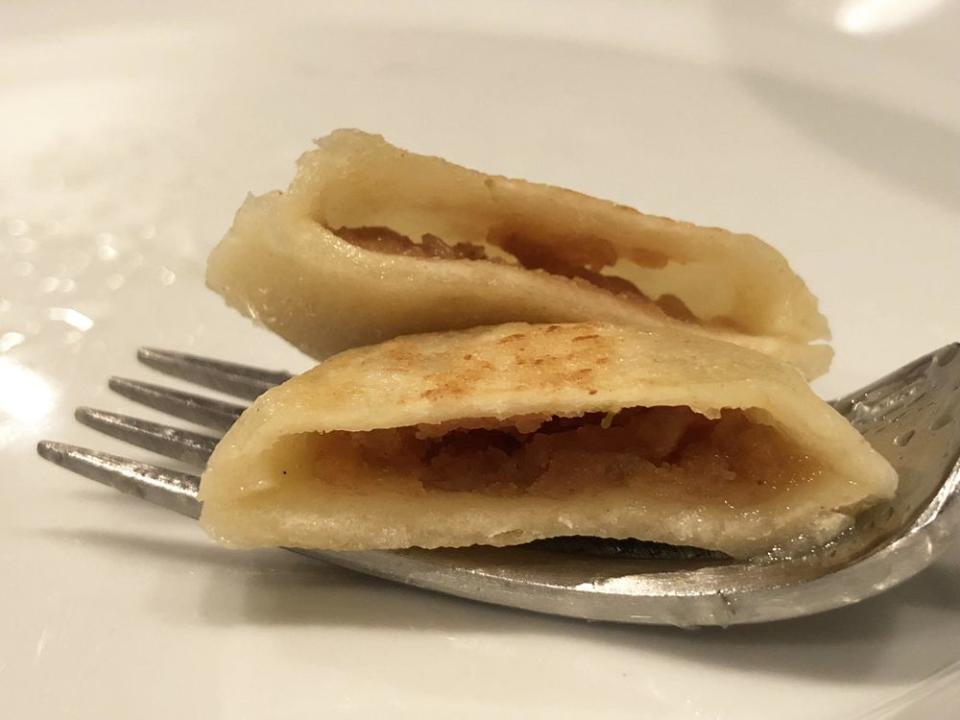PB&J Dumplings Are the Best Thing Since Ditching the Whole Sliced Bread Part
There is a dumpling in every culture, from the fingertip-sized Turkish manti to the giant soup dumplings of Hong Kong, from crispy samosas and empanadas to slippery pierogies and kreplach. They can be elegant, like a large Italian oviolo, sensuously oozing barely warmed egg yolk, or completely rustic, like a hand pinched vareniki. They are boiled, fried, sautéed, steamed and baked. The impulse to fill some sort of dough with something savory or sweet is as ancient as cooking itself.
One of my favorite versions of dumplings are the Russian pelmeni, which are small, one-bite delights that can be filled with meats or potato, cheese or fruit, usually served boiled and tossed in melted butter with the barest splash of vinegar, maybe with some sour cream on the side. The dough is a bit on the chewy side, much like a pasta, and a perfect foil to whatever you think to fill them with.
While some people make the little pillows by hand, think about the size of a tortellini, almost everyone I’ve met makes theirs in a pelmenitsa, a round mold with a honeycomb grid comprising 37 hexagonal divots. You just roll out two sheets of dough, lay one over the grid, fill the divots, lay the other on top and roll over the whole thing with your rolling pin to cut and seal the pelmeni.

Making 37 dumplings in one go is good because one serving of these bite-sized beauties is about 20 dumplings, so you essentially have to make them by the hundreds. Luckily, they freeze beautifully, so you can have a pelmeni-making party and then keep a stash of them frozen for future dumpling cravings.
Pelmeni, whether store bought or homemade are an amazing brunch item. You can boil them up in advance and then toss them in a skillet of brown butter to heat through and crisp up a bit before your guests arrive. They travel pretty well, so they are a fun potluck dish. Think of them as Russian dim sum and you’ll start to see why brunch is my favorite time to eat them.
I love the traditional flavors, beef and onion, potato and cheese, lamb and dill, and sour cherry, but I’m also lucky enough to live in a city with a large Russian population, so I have access to those in freezer cases and delis around town. There is even a whole restaurant here devoted strictly to pelmeni, and they make several tasty versions. So if I’m going to make my own, I often do it as an experiment in non-traditional fillings.
My favorite is peanut butter and jelly. The classic combo is soul-soothing and satisfying, and works brilliantly in pelmeni. The little one-bite dumplings are the perfect delivery service for PB&J, so you don’t have to worry about drippiness, or get a giant choking mouthful of liquid peanut butter.
I also cut the peanut butter with whole milk ricotta cheese, because it needs a bit of stability, and have fun flavoring the filling a million ways. Curry power in peanut butter is delicious, and paired with mango chutney it goes to a whole new place. I mix in fresh lime zest and red pepper flakes and match it with ginger preserves. A little honey swirled into the peanut butter makes a delightful pairing with a small piece of fresh banana, and even the regular peanut butter can get some surprising oomph from hot pepper jelly. You can play with your fillings, keeping them as nostalgic or creative as you like.
A pelmenitsa is available inexpensively on Amazon or at Russian markets, and I cannot recommend them highly enough for ease of assembly. If you assemble by hand, you’ll get fewer dumplings. If the idea of rolling and cutting dough just makes you nuts, buy premade round gyoza or wonton wrappers and just do the fillings.
PB&J Pelmeni

Makes about 100-120, give or take, or servings for 5-6 people
For the dough
(adapted from Kachka by Bonnie Frumkin Morales)
This is essentially a pasta dough, with a little extra tenderness from the water. You can make it by hand, but then you have to knead it for like 25 minutes, so I highly recommend doing this in your stand mixer.
Ingredients
3 1/2 cups bread flour (you can sub all purpose)
1 tablespoon kosher salt
1 large egg, beaten
3/4 cup plus 2 tablespoons cold water
Directions
In the bowl of your stand mixer fitted with a dough hook, blend the flour and salt, then add the egg. Turn the mixer on low and slowly drizzle in the water. Once you have a dough ball, turn the mixer to the second speed and let knead for 10 full minutes. Wrap the dough in plastic wrap and set aside at room temp for at least an hour.
For the fillings
Basic peanut butter filling
8 ounces natural creamy peanut butter, I use Maranatha No-Stir Creamy at room temperature
8 ounces whole milk ricotta
Mix in a small bowl till completely blended, then set aside.
You’ll also need one jar of the jam, jelly or preserves of your choice.
Peanut butter mix-ins
Zest of one lime and 1 teaspoon of red pepper flakes (pairs well with ginger jam)
2 teaspoons curry powder (pairs with mango chutney)
2 teaspoons cinnamon (pairs with apple butter)
1 tablespoon honey (pairs with a small piece of fresh banana)
1 tablespoon Sriracha (pairs with coconut jam)
Assemble
1. Cut your dough into 8 equal pieces, and keep the pieces you aren’t working with under a damp towel or plastic wrap so they don’t dry out. Roll a piece of dough just slightly larger than the pelmenitsa, I don’t need flour when I do this on my counters, but if yours stick, you can lightly flour your board. Drape it loosely over the top of the mold. Press gently so that you can see where all the divots are. Fill each divot with 1 scant teaspoon TOTAL of your fillings, being careful not to get filling where the sealing edges are. I use a piping bag for the jam or jelly and put those down first, then I roll little balls of the peanut butter filling and put them on top. Use about a scant 1/2 teaspoon of jam and a scant 1/2 teaspoon of peanut butter. Don’t over-fill or the pelmeni won’t seal.
2. Roll out a second sheet of dough. If you did not have to flour your dough, just lay it gently over the top of your filled mold. If you did flour your dough, spritz the dough lightly with water before laying it damp side down over your filled mold. Press gently all over to get the dough settled, then using your rolling pin, roll firmly over the mold to cut and seal your dumplings. Flip the mold over onto a parchment lined sheet pan and using your thumb, very gently push the pelmeni out onto the paper. Separate any that are stuck together along a seam, and then repeat until your dough is gone.
If you want to freeze them for later use, freeze them solid on the sheet pan and then stash in Ziploc bags. Cook from frozen.
Cook
1. Bring a large pot of water to a boil. While it is coming to a boil, melt some butter, about 2 tablespoons for every 40 dumplings. When the butter is melted, stir in 1 teaspoon of apple cider vinegar for every 2 tablespoons of butter. When the water is boiling, reduce the heat so that it is a lazy boil, not vigorous, and add the dumplings. Cook for about 4-6 minutes, stirring occasionally, until all of the dumplings have risen to the top and they are cooked through. If you are cooking from frozen they might take 7-8 minutes. As with pasta, taste one or two before straining.
2. Strain the cooked pelmeni and drop them immediately into a large bowl with the melted butter and vinegar and toss to coat. If you prefer a bit of crisp, melt the butter in a nonstick skillet until just starting to brown, add the vinegar and then the dumplings, tossing to coat and sautéing until they get a bit browned and crispy.
Serve hot, with sour cream on the side if you like.
If you don’t have a pelmenitsa, you can use a ravioli mold or potsticker mold. To make totally by hand, cut the dough into circles with a 2-inch ring cutter, and pinch together in half-moon shapes, again using a bit of water if you needed to flour your dough for rolling.
If you want to make more traditional pelmeni, I highly recommend you check out the cookbook Kachka by Bonnie Frumkin Morales. She has a whole dumpling chapter and this dough recipe is lightly adapted from hers.


